2016 Hyundai Sonata Hybrid fuel
[x] Cancel search: fuelPage 667 of 708
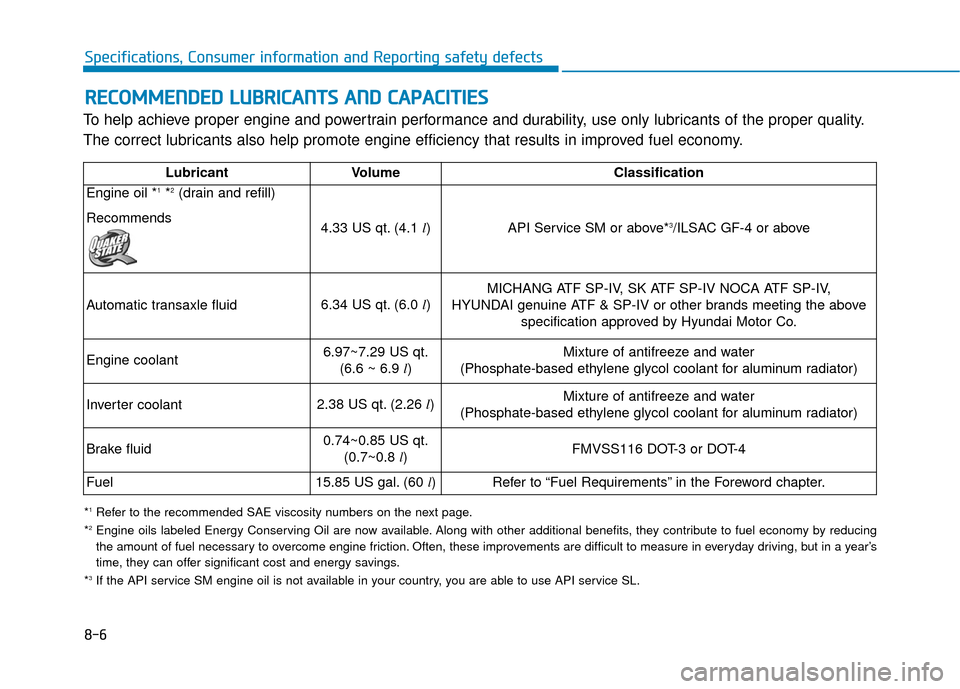
8-6
Specifications, Consumer information and Reporting safety defects
To help achieve proper engine and powertrain performance and durability, use only lubricants of the proper quality.
The correct lubricants also help promote engine efficiency that results in improved fuel economy.
R R E
EC
CO
O M
M M
ME
EN
N D
DE
ED
D
L
L U
U B
BR
RI
IC
C A
A N
N T
TS
S
A
A N
N D
D
C
C A
A P
PA
A C
CI
IT
T I
IE
E S
S
*1Refer to the recommended SAE viscosity numbers on the next page.
*2Engine oils labeled Energy Conserving Oil are now available. Along with other additional benefits, they contribute to fuel econo my by reducing
the amount of fuel necessary to overcome engine friction. Often, these improvements are difficult to measure in everyday driving, but in a year’s
time, they can offer significant cost and energy savings.
*
3If the API service SM engine oil is not available in your country, you are able to use API service SL.
LubricantVolume Classification
Engine oil *
1*2(drain and refill)
Recommends
4.33 US qt. (4.1 l)
API Service SM or above*3/ILSAC GF-4 or above
Automatic transaxle fluid
6.34 US qt. (6.0 l)MICHANG ATF SP-IV, SK ATF SP-IV NOCA ATF SP-IV,
HYUNDAI genuine ATF & SP-IV or other brands meeting the above specification approved by Hyundai Motor Co.
Engine coolant6.97~7.29 US qt.(6.6 ~ 6.9 l)Mixture of antifreeze and water
(Phosphate-based ethylene glycol coolant for aluminum radiator)
Inverter coolant
2.38 US qt. (2.26 l) Mixture of antifreeze and water
(Phosphate-based ethylene glycol coolant for aluminum radiator)
Brake fluid
0.74~0.85 US qt. (0.7~0.8 l) FMVSS116 DOT-3 or DOT-4
Fuel15.85 US gal. (60 l)Refer to “Fuel Requirements” in the Foreword chapter.
Page 668 of 708
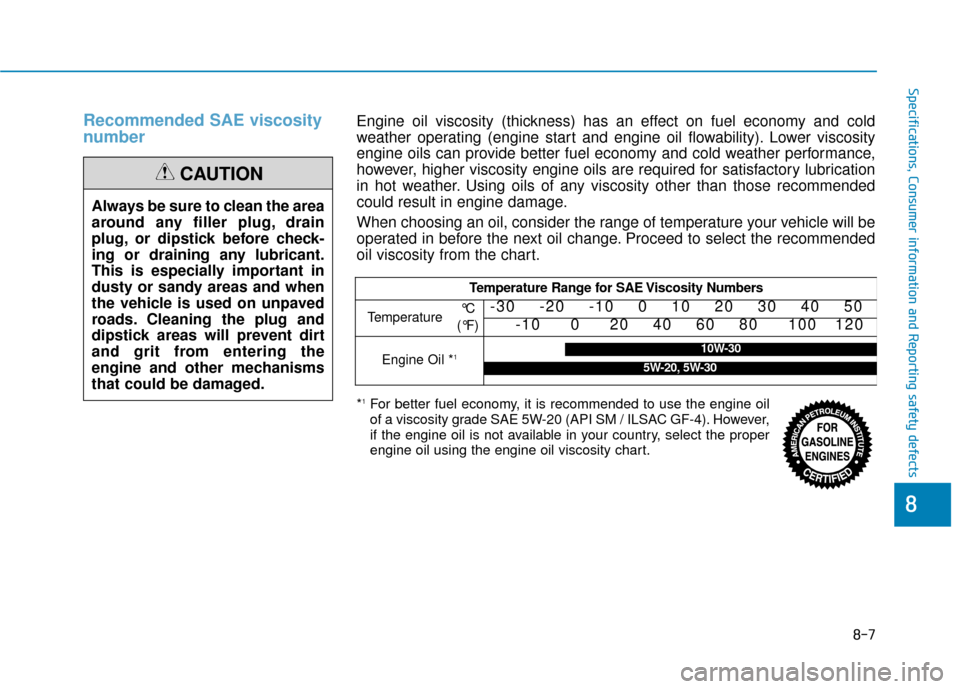
8-7
88
Specifications, Consumer information and Reporting safety defects
Recommended SAE viscosity
number
Always be sure to clean the area
around any filler plug, drain
plug, or dipstick before check-
ing or draining any lubricant.
This is especially important in
dusty or sandy areas and when
the vehicle is used on unpaved
roads. Cleaning the plug and
dipstick areas will prevent dirt
and grit from entering the
engine and other mechanisms
that could be damaged.
CAUTION
Engine oil viscosity (thickness) has an effect on fuel economy and cold
weather operating (engine start and engine oil flowability). Lower viscosity
engine oils can provide better fuel economy and cold weather performance,
however, higher viscosity engine oils are required for satisfactory lubrication
in hot weather. Using oils of any viscosity other than those recommended
could result in engine damage.
When choosing an oil, consider the range of temperature your vehicle will be
operated in before the next oil change. Proceed to select the recommended
oil viscosity from the chart.
Temperature Range for SAE Viscosity Numbers
Temperature -30 -20 -10 0 10 20 30 40 50
-10 0 20 40 60 80 100 120
Engine Oil *110W-30
5W-20, 5W-30
°C
(°F)
*1For better fuel economy, it is recommended to use the engine oil
of a viscosity grade SAE 5W-20 (API SM / ILSAC GF-4). However,
if the engine oil is not available in your country, select the proper
engine oil using the engine oil viscosity chart.
Page 677 of 708
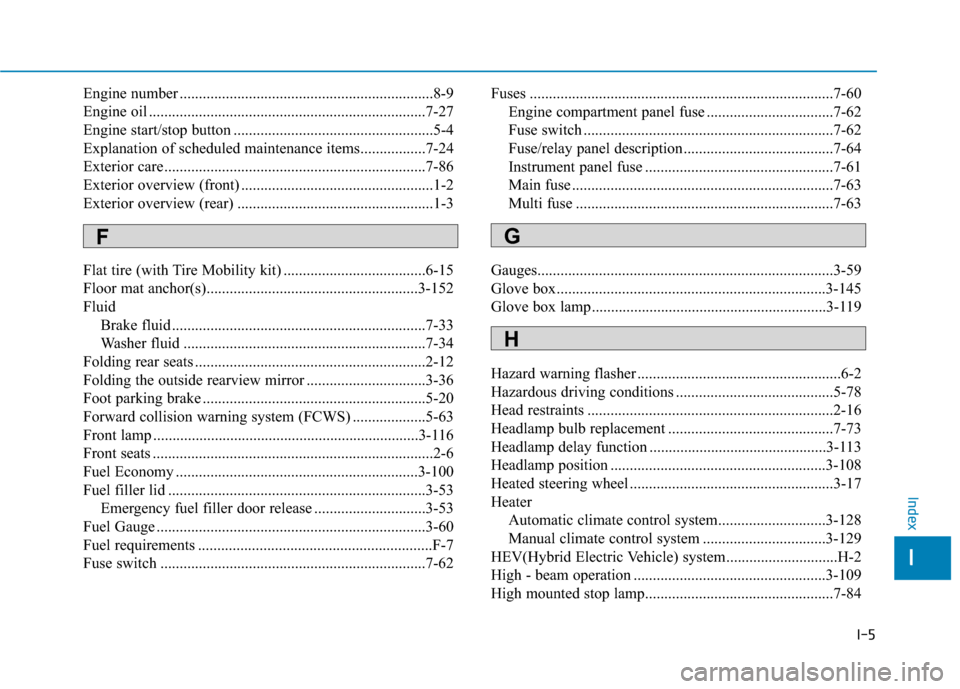
I-5
Engine number ..................................................................8-9
Engine oil ........................................................................\
7-27
Engine start/stop button ....................................................5-4
Explanation of scheduled maintenance items.................7-24
Exterior care....................................................................7-86\
Exterior overview (front) ..................................................1-2
Exterior overview (rear) ...................................................1-3
Flat tire (with Tire Mobility kit) .....................................6-15
Floor mat anchor(s).......................................................3-152
FluidBrake fluid ..................................................................7-33
Washer fluid ...............................................................7-34
Folding rear seats ............................................................2-12
Folding the outside rearview mirror ...............................3-36
Foot parking brake ..........................................................5-20
Forward collision warning system (FCWS) ...................5-63
Front lamp .....................................................................3-1\
16
Front seats ........................................................................\
.2-6
Fuel Economy ...............................................................3-100
Fuel filler lid ...................................................................3-53 Emergency fuel filler door release .............................3-53
Fuel Gauge ......................................................................3-\
60
Fuel requirements .............................................................F-7
Fuse switch .....................................................................7-6\
2 Fuses ........................................................................\
.......7-60
Engine compartment panel fuse .................................7-62
Fuse switch .................................................................7-62
Fuse/relay panel description .......................................7-64
Instrument panel fuse .................................................7-61
Main fuse ....................................................................7-63\
Multi fuse ...................................................................7-63
Gauges........................................................................\
.....3-59
Glove box......................................................................3-\
145
Glove box lamp .............................................................3-119
Hazard warning flasher .....................................................6-2
Hazardous driving conditions .........................................5-78
Head restraints ................................................................2-16
Headlamp bulb replacement ...........................................7-73
Headlamp delay function ..............................................3-113
Headlamp position ........................................................3-108
Heated steering wheel .....................................................3-17
Heater Automatic climate control system............................3-128
Manual climate control system ................................3-129
HEV(Hybrid Electric Vehicle) system.............................H-2
High - beam operation ..................................................3-109
High mounted stop lamp.................................................7-84
I
Index
FG
H
Page 682 of 708

I-10
Steering wheel audio control ............................................4-3
Storage compartment ....................................................3-145Center console storage .............................................3-145
Glove box .................................................................3-145
Multi box ..................................................................3-146
Sunglass holder ........................................................3-146
Sunglass holder .............................................................3-146
Sunroof, see panoramic sunroof .....................................3-42
Sunvisor ........................................................................\
3-148
Telescope steering ...........................................................3-17
The components of hybrid system .................................H-18
Theft-alarm system .........................................................3-13
Tilt steering .....................................................................3-1\
7
Tire chains .......................................................................5\
-83
Tire Mobility kit..............................................................6-15
Tire pressure monitoring system(TPMS) .........................6-9
Tire rotation ....................................................................7-47\
Tire specification and pressure label ................................8-9
Tires and wheels ......................................................7-44, 8-4 Checking tire inflation pressure .................................7-46
Low aspect ratio tires .................................................7-58
Recommended cold tire inflation pressures ...............7-45
Tire care ......................................................................7-\
44
Tire maintenance ........................................................7-50
Tire replacement .........................................................7-48 Tire rotation ................................................................7-47
Tire sidewall labeling .................................................7-50
Tire traction ................................................................7-49
Wheel alignment and tire balance ..............................7-48
Wheel replacement .....................................................7-48
Towing ........................................................................\
....6-22
Trailer towing..................................................................5-92
Transaxle Automatic transaxle....................................................5-12
Shift lock system ........................................................5-16
Shift-lock release ........................................................5-16
Trip A/B ........................................................................\
..3-99
Trip computer..................................................................3-98 Digital speedometer..................................................3-102
Fuel Economy ..........................................................3-100
Trip A/B ......................................................................3-\
99
Trunk ........................................................................\
.......3-47 Smart trunk .................................................................3-50
Trunk room lamp ..........................................................3-118
Turn by turn (TBT) mode ...............................................3-90
Turn signals ...................................................................3-112
User settings mode..........................................................3-93
Index
T
U
Page 685 of 708
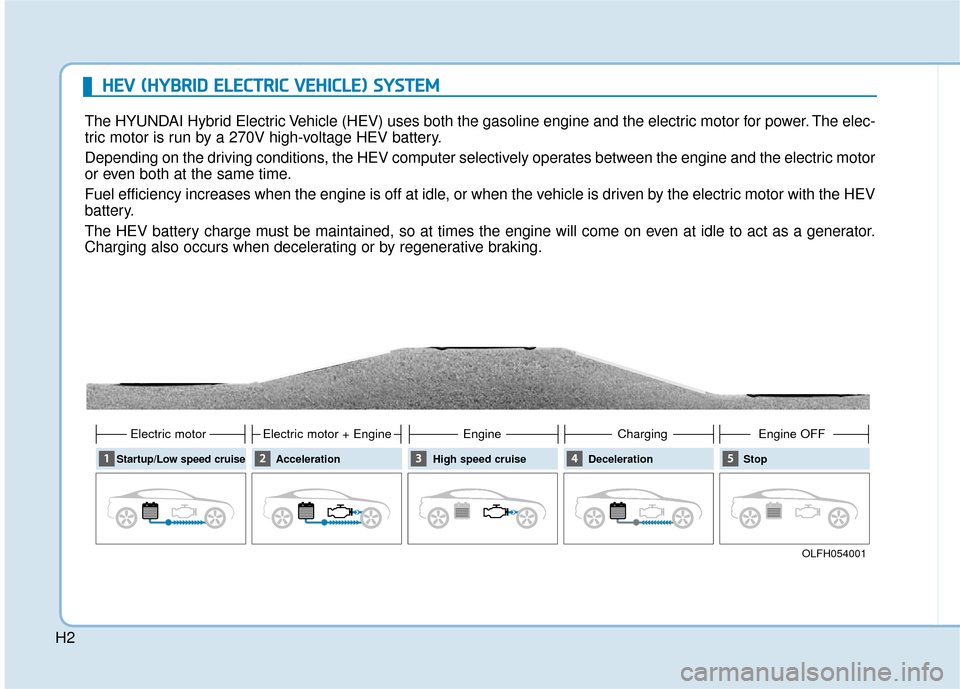
H2
H
HE
EV
V
(
( H
H Y
Y B
BR
RI
ID
D
E
E L
LE
E C
CT
T R
R I
IC
C
V
V E
EH
H I
IC
C L
LE
E )
)
S
S Y
Y S
ST
T E
EM
M
The HYUNDAI Hybrid Electric Vehicle (HEV) uses both the gasoline engine and the electric motor for power. The elec-
tric motor is run by a 270V high-voltage HEV battery.
Depending on the driving conditions, the HEV computer selectively operates between the engine and the electric motor
or even both at the same time.
Fuel efficiency increases when the engine is off at idle, or when the vehicle is driven by the electric motor with the HEV
battery.
The HEV battery charge must be maintained, so at times the engine will come on even at idle to act as a generator.
Charging also occurs when decelerating or by regenerative braking.
OLFH054001
Startup/Low speed cruise
Electric motor
Acceleration
Electric motor + Engine
High speed cruise
Engine
Deceleration
Charging
Stop
Engine OFF
Page 686 of 708
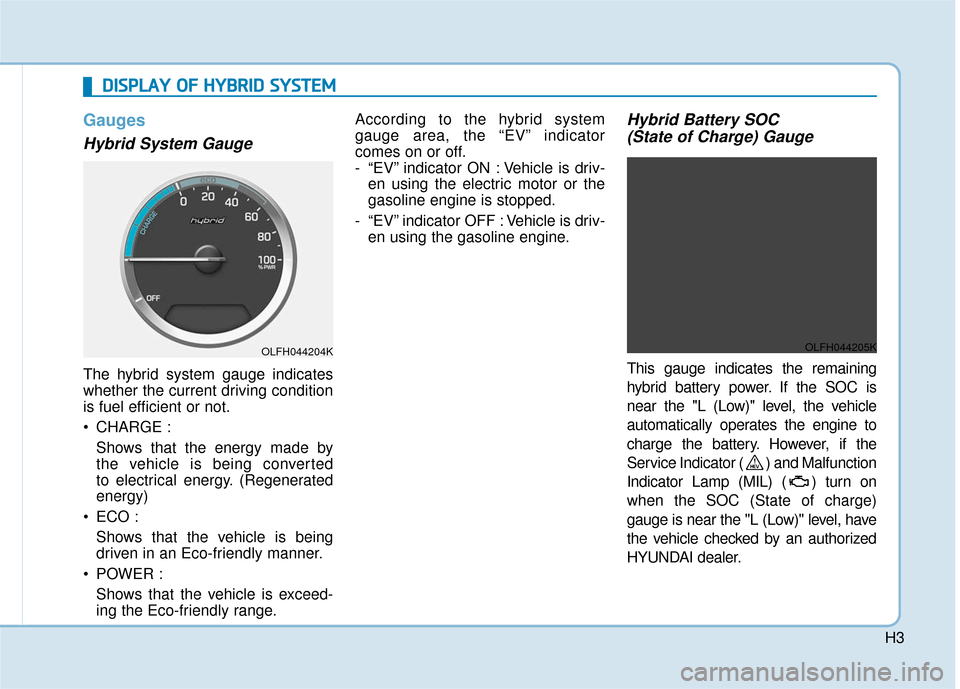
H3
D
DI
IS
S P
P L
LA
A Y
Y
O
O F
F
H
H Y
Y B
BR
RI
ID
D
S
S Y
Y S
ST
T E
EM
M
Gauges
Hybrid System Gauge
The hybrid system gauge indicates
whether the current driving condition
is fuel efficient or not.
• CHARGE :
Shows that the energy made by
the vehicle is being converted
to electrical energy. (Regenerated
energy)
ECO : Shows that the vehicle is being
driven in an Eco-friendly manner.
POWER : Shows that the vehicle is exceed-
ing the Eco-friendly range. According to the hybrid system
gauge area, the “EV” indicator
comes on or off.
- “EV” indicator ON : Vehicle is driv-
en using the electric motor or the
gasoline engine is stopped.
- “EV” indicator OFF : Vehicle is driv- en using the gasoline engine.
Hybrid Battery SOC (State of Charge) Gauge
This gauge indicates the remaining
hybrid battery power. If the SOC is
near the "L (Low)" level, the vehicle
automatically operates the engine to
charge the battery. However, if the
Service Indicator ( ) and Malfunction
Indicator Lamp (MIL) ( ) turn on
when the SOC (State of charge)
gauge is near the "L (Low)" level, have
the vehicle checked by an authorized
HYUNDAI dealer.
OLFH044204KOLFH044205K
Page 690 of 708
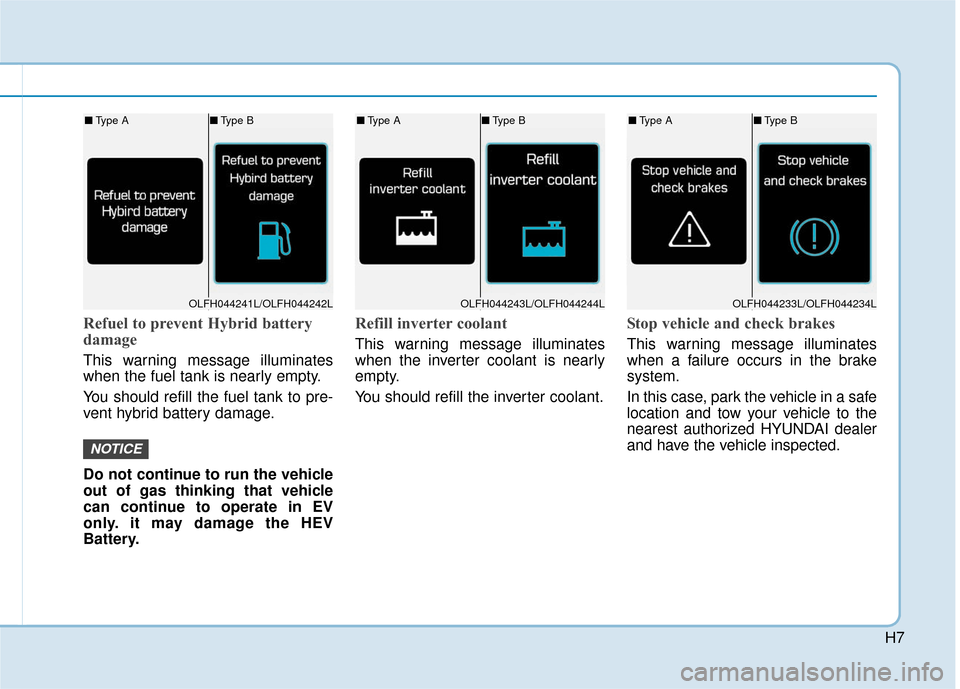
H7
Refuel to prevent Hybrid battery
damage
This warning message illuminates
when the fuel tank is nearly empty.
You should refill the fuel tank to pre-
vent hybrid battery damage.
Do not continue to run the vehicle
out of gas thinking that vehicle
can continue to operate in EV
only. it may damage the HEV
Battery.
Refill inverter coolant
This warning message illuminates
when the inverter coolant is nearly
empty.
You should refill the inverter coolant.
Stop vehicle and check brakes
This warning message illuminates
when a failure occurs in the brake
system.
In this case, park the vehicle in a safe
location and tow your vehicle to the
nearest authorized HYUNDAI dealer
and have the vehicle inspected.
NOTICE
OLFH044241L/OLFH044242L
■Type A ■Type B
OLFH044243L/OLFH044244L
■Type A ■Type B
OLFH044233L/OLFH044234L
■Type A ■Type B
Page 691 of 708
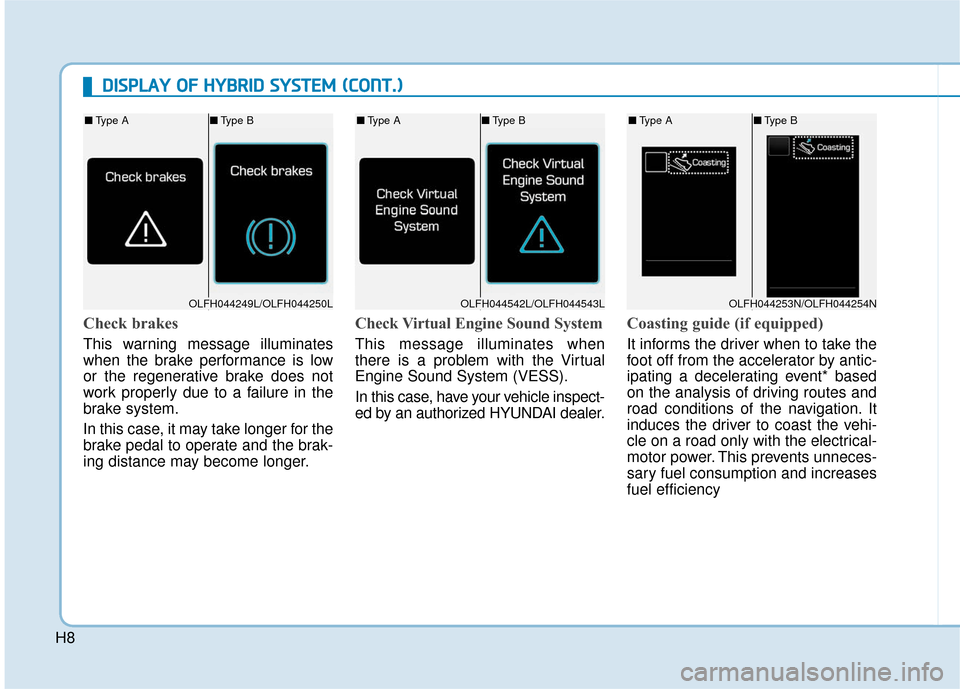
H8
Check brakes
This warning message illuminates
when the brake performance is low
or the regenerative brake does not
work properly due to a failure in the
brake system.
In this case, it may take longer for the
brake pedal to operate and the brak-
ing distance may become longer.
Check Virtual Engine Sound System
This message illuminates when
there is a problem with the Virtual
Engine Sound System (VESS).
In this case, have your vehicle inspect-
ed by an authorized HYUNDAI dealer.
Coasting guide (if equipped)
It informs the driver when to take the
foot off from the accelerator by antic-
ipating a decelerating event* based
on the analysis of driving routes and
road conditions of the navigation. It
induces the driver to coast the vehi-
cle on a road only with the electrical-
motor power. This prevents unneces-
sary fuel consumption and increases
fuel efficiency
D DI
IS
S P
P L
LA
A Y
Y
O
O F
F
H
H Y
Y B
BR
RI
ID
D
S
S Y
Y S
ST
T E
EM
M
(
( C
C O
O N
NT
T.
.)
)
OLFH044542L/OLFH044543L
■ Type A ■Type B
OLFH044249L/OLFH044250L
■Type A ■Type B
OLFH044253N/OLFH044254N
■Type A ■Type B